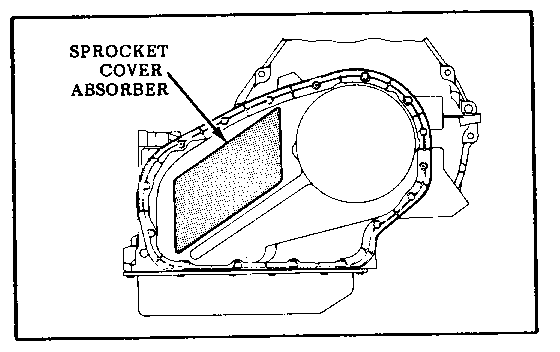TRANS. SPROCKET COVER NOISE 325-4L TRANS.COVER ABSORBER

TRANSMISSION SPROCKET COVER NOISE - 1982-1983 E/K MODELS WITH 325-4L
Some 1982 and early 1983 E/K cars may exhibit a noise which sounds like a final drive ring and pinion whine at vehicle speeds between 32 and 42 mph. This noise is most prevalent under road load and is caused by the plastic transmission sprocket cover vibrating and transmitting the noise like a speaker. This noise is most noticeable on vehicles equipped with HT4100 engines and 3.15:1 final drive ratios.
A transmission sprocket cover absorber assembly (P/N 1627092) has been released to correct this condition. The following procedure should be used when installing this absorber.
1. Assure that transmission is warm before proceeding with preparation and installation of the adhesive backed steel patch.
- Vehicle, if cold, should be run a minimum of 15 minutes to heat transmission over 120 DEG F.
2. Raise vehicle on hoist and using caution to avoid hot exhaust system, clean flat area on transmission sprocket above stiffening rib and to the left of the dome using the following procedure:
- First, use a water and soap solution followed with a clear water rinse.
- Then wipe surface using a clean cloth saturated with a 50/50 mixture of isopropyl alcohol and water.
- Next, dry surface with a clean cloth.
- Finally, lightly scuff surface using 80 grit sandpaper.
3. Place absorber in position on sprocket cover before removing protective backing, to establish correct mounting position (refer to illustration below). The adhesive is pressure sensitive and no repositioning is possible after installation.
4. Remove protective backing on adhesive side of absorber, carefully position absorber in predetermined location, and firmly press in position. Pressure should be applied to entire surface area of patch.
For warranty purposes, use labor operation number T6062 at .5 hour.

General Motors bulletins are intended for use by professional technicians, not a "do-it-yourselfer". They are written to inform those technicians of conditions that may occur on some vehicles, or to provide information that could assist in the proper service of a vehicle. Properly trained technicians have the equipment, tools, safety instructions and know-how to do a job properly and safely. If a condition is described, do not assume that the bulletin applies to your vehicle, or that your vehicle will have that condition. See a General Motors dealer servicing your brand of General Motors vehicle for information on whether your vehicle may benefit from the information.
